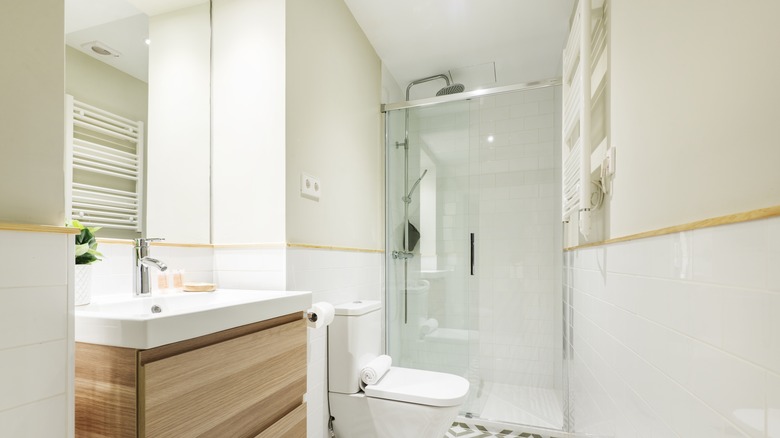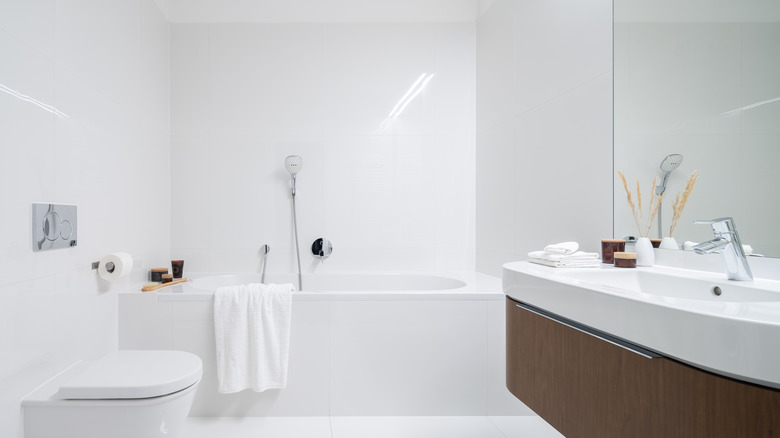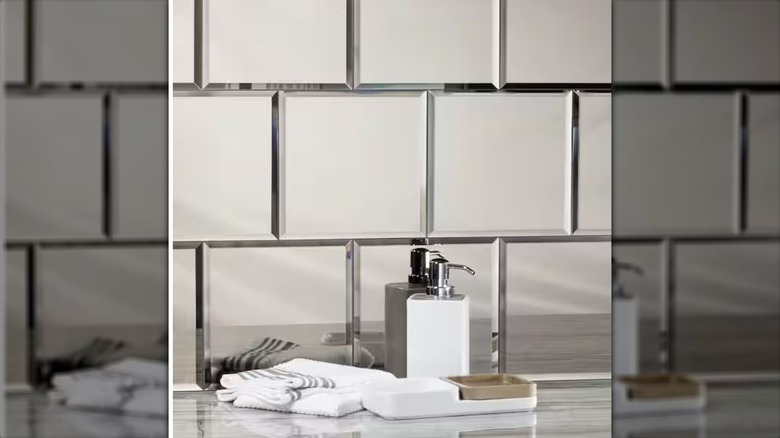HGTV's Emily Henderson Says This Bathroom Design Rule Is Meant To Be Broken
Floor-to-ceiling mirrors in bathroom spaces are often a sight at luxe hotels and spas, which may leave you asking if using one in your bathroom would be a stylish alternative to conventional smaller-size vanity or wall mirrors. According to designer Emily Henderson, full-length mirrors behind a vanity or elsewhere in the bathroom can be a great way to maximize aesthetic concerns and functionality, despite the often-held belief that they suit more modern and contemporary bathrooms far better than traditional or vintage-inspired ones. Much depends on how the use of the mirror is executed.
Henderson, in a blog piece at Style by Emily Henderson on bucking common design taboos, showcases a bathroom with an entire wall mirror floor to ceiling that extends behind a vanity to the floor. Henderson says, "I almost stole this move for our primary bath and am kinda regretting not doing it right now. But Brian and Anne thought it was too contemporary for our house (I still don't think so). But boy does it look awesome."
Pros and cons
There are many benefits of a floor-to-ceiling bathroom mirror, particularly behind the vanity. Large bathroom mirrors can be an instant way to change the shape and dimensions of a room. Because it extends to the floor, it can also make the space under a cabinet feel lighter and less dense, which is great for small spaces. Full-length mirrors also maximize the light in a darker bathroom, particularly great if natural light is limited and you want to make the most of it. The continuation of the unbroken vertical lines will also make the room seem higher and more vast. These mirrors are also great for functionality since you can get a larger mirror view head to toe when getting ready. They are also great for behind sinks and vanities two people use at once.
As Emily Henderson mentions, full-wall mirrors are often found in more contemporary and sleek spaces, making many reticent to use them in other bathroom design aesthetics, where they can seem out of place or too severe in their lines. They are often more difficult to keep clean and can suffer more moisture damage, chipping, and cracking than smaller mirrors. In addition, the lack of a frame immediately looks more contemporary, while homes with more traditional, farmhouse, and rustic-style bathrooms usually use framed mirrors as a design element.
Getting the look
These drawbacks, however, do not mean you cannot make full-length mirrors work in your space, whatever your design aesthetics. While they can be perfect for modern and minimalist bathrooms with sleek lines, there are ways to tweak the design to better suit other styles. For a more vintage and rustic-inspired room, consider using a different variety of glass, like copper or these aged, antiqued glass panels from Wescover, which look like they are ages old and can be used the full length of a wall. Glass tiles come in a multitude of styles, from more ornate shaped varieties to staid and classic subway tile, and can look amazing on a vanity wall or in a shower/tub surround.
There are also ways to minimize the austere sleekness of a full-length mirror, including framing it out with a wood or gilt frame around the perimeter of the glass. This Art Deco-inspired piece from Bed Bath & Beyond is a great way to break up a dense mirrored wall. If you are looking for a simple renovation-free well to bring the effect of a full-length mirror into the bathroom around a sink or vanity, consider making a full collage wall with different-shaped antique beveled or handheld mirrors for a Victorian look., which will still give you a classic look while also making the space seem more bright and open.


